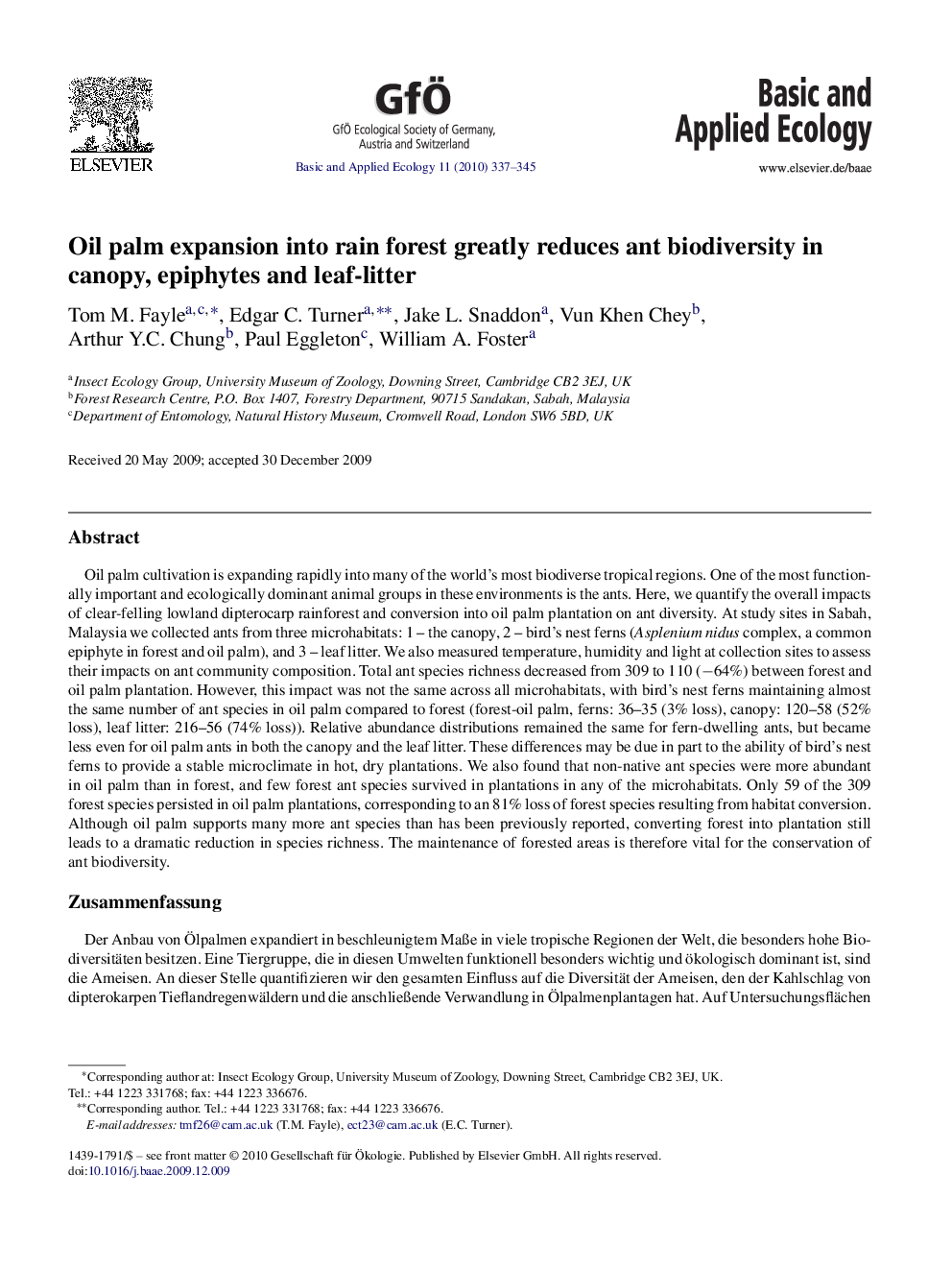| Article ID | Journal | Published Year | Pages | File Type |
|---|---|---|---|---|
| 4384392 | Basic and Applied Ecology | 2010 | 9 Pages |
Oil palm cultivation is expanding rapidly into many of the world's most biodiverse tropical regions. One of the most functionally important and ecologically dominant animal groups in these environments is the ants. Here, we quantify the overall impacts of clear-felling lowland dipterocarp rainforest and conversion into oil palm plantation on ant diversity. At study sites in Sabah, Malaysia we collected ants from three microhabitats: 1 – the canopy, 2 – bird's nest ferns (Asplenium nidus complex, a common epiphyte in forest and oil palm), and 3 – leaf litter. We also measured temperature, humidity and light at collection sites to assess their impacts on ant community composition. Total ant species richness decreased from 309 to 110 (−64%) between forest and oil palm plantation. However, this impact was not the same across all microhabitats, with bird's nest ferns maintaining almost the same number of ant species in oil palm compared to forest (forest-oil palm, ferns: 36–35 (3% loss), canopy: 120–58 (52% loss), leaf litter: 216–56 (74% loss)). Relative abundance distributions remained the same for fern-dwelling ants, but became less even for oil palm ants in both the canopy and the leaf litter. These differences may be due in part to the ability of bird's nest ferns to provide a stable microclimate in hot, dry plantations. We also found that non-native ant species were more abundant in oil palm than in forest, and few forest ant species survived in plantations in any of the microhabitats. Only 59 of the 309 forest species persisted in oil palm plantations, corresponding to an 81% loss of forest species resulting from habitat conversion. Although oil palm supports many more ant species than has been previously reported, converting forest into plantation still leads to a dramatic reduction in species richness. The maintenance of forested areas is therefore vital for the conservation of ant biodiversity.
ZusammenfassungDer Anbau von Ölpalmen expandiert in beschleunigtem Maße in viele tropische Regionen der Welt, die besonders hohe Biodiversitäten besitzen. Eine Tiergruppe, die in diesen Umwelten funktionell besonders wichtig und ökologisch dominant ist, sind die Ameisen. An dieser Stelle quantifizieren wir den gesamten Einfluss auf die Diversität der Ameisen, den der Kahlschlag von dipterokarpen Tieflandregenwäldern und die anschließende Verwandlung in Ölpalmenplantagen hat. Auf Untersuchungsflächen in Sabah, Malaysia, sammelten wir in drei Mikrohabitaten die Ameisen: (1) im Kronendach, (2) in Nestfarnen (Asplenium nidus-Komplex, einem verbreiteten Epiphyten im Wald und auf Ölpalmen) und (3) in der Streu. Wir maßen außerdem die Temperatur, die Luftfeuchte und das Licht an den Sammelorten, um den Einfluss auf die Zusammensetzung der Ameisengesellschaften zu bewerten. Die Gesamtartenzahl der Ameisen verringerte sich von 309 auf 110 (−64 %) vom Wald zur Ölpalmenplantage. Dieser Einfluss war jedoch nicht in allen Mikrohabitaten der gleiche, da in Nestfarnen fast die gleiche Anzahl von Ameisenarten in Ölpalmen wie im Wald erhalten blieben (Wald-Ölpalmen, Farne: 36–35 (3% Verlust), Kronendach: 120–58 (52% Verlust), Laubstreu: 216–56 (74% Verlust)). Die Verteilungen der relativen Abundanzen blieben für farnbewohnenden Ameisen bestehen, waren jedoch in Ölpalmen sowohl im Kronendach als auch in der Laubstreu weniger gleichverteilt. Diese Unterschiede können zum Teil darauf zurückgeführt werden, dass die Nestfarne in den heißen und staubigen Plantagen ein relativ stabiles Mikroklima zur Verfügung stellen können. Wir fanden außerdem heraus, dass nicht-einheimische Ameisenarten in den Ölpalmen häufiger als im Wald waren und dass nur wenige Waldameisenarten in sämtlichen Mikrohabitaten überlebten. Nur 59 der 309 Waldarten blieben in den Ölpalmenplantagen bestehen, so dass ein Verlust von 81% durch die Habitatumwandlung entstand. Auch wenn Ölpalmen sehr viel mehr Arten zulassen, als bisher berichtet wurde, führt die Umwandlung der Wälder in Plantagen immer noch zu dramatischen Verlusten im Artenreichtum. Der Erhalt bewaldeter Gebiete ist daher lebenswichtig für den Erhalt der Ameisenbiodiversität.
